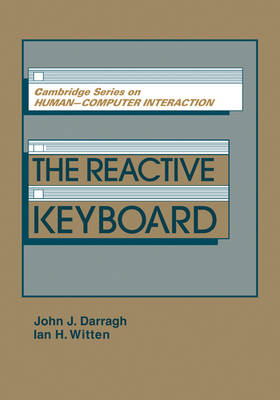
The Reactive Keyboard
Seiten
2010
Cambridge University Press (Verlag)
978-0-521-14476-6 (ISBN)
Cambridge University Press (Verlag)
978-0-521-14476-6 (ISBN)
This 1992 book discusses a functional architecture for communication aids and the idea of automatically supplying the intrinsic redundancy contained in natural communication. The distinctions between adaptive and non-adaptive models of communication are shown and details are given of working predictive text generation systems, specifically the Reactive Keyboard.
For people with various forms of physical disability, extreme slowness of communication is commonplace. In the first part of this 1992 book a functional architecture for communication aids is discussed and the idea of automatically supplying the intrinsic redundancy contained in natural communication is explained. The distinctions between adaptive and non-adaptive models of communication are shown and details are given of working predictive text generation systems. One such system is the Reactive Keyboard, and in the second part of the book this is described. It greatly speeds communication by predicting the user's next response, although it does not always predict correctly. The guesses are made on the basis of previous answers and thus can conform to whatever kind of text is entered. This will be of great value to all involved in helping disabled users interact with computers.
For people with various forms of physical disability, extreme slowness of communication is commonplace. In the first part of this 1992 book a functional architecture for communication aids is discussed and the idea of automatically supplying the intrinsic redundancy contained in natural communication is explained. The distinctions between adaptive and non-adaptive models of communication are shown and details are given of working predictive text generation systems. One such system is the Reactive Keyboard, and in the second part of the book this is described. It greatly speeds communication by predicting the user's next response, although it does not always predict correctly. The guesses are made on the basis of previous answers and thus can conform to whatever kind of text is entered. This will be of great value to all involved in helping disabled users interact with computers.
List of figures and tables; Acknowledgments; Part I. Communication Disability and Predictive Text Generation: 1. Communication and communication aids; 2. Predictive text generation systems; 3. The Predict system and its evaluation; Part II. The Reactive Keyboard: 4. The user interface; 5. The prediction mechanism; 6. Implementation; 7. Concluding remarks; Appendix A. Documentation for RK-UNIX; Appendix B. Documentation for RK-PC; Appendix C. Code for the Reactive Keyboard; Appendix D. List of sources; References; Index.
| Erscheint lt. Verlag | 24.6.2010 |
|---|---|
| Reihe/Serie | Cambridge Series on Human-Computer Interaction |
| Zusatzinfo | Worked examples or Exercises |
| Verlagsort | Cambridge |
| Sprache | englisch |
| Maße | 178 x 254 mm |
| Gewicht | 360 g |
| Themenwelt | Informatik ► Software Entwicklung ► User Interfaces (HCI) |
| ISBN-10 | 0-521-14476-0 / 0521144760 |
| ISBN-13 | 978-0-521-14476-6 / 9780521144766 |
| Zustand | Neuware |
| Haben Sie eine Frage zum Produkt? |
Mehr entdecken
aus dem Bereich
aus dem Bereich
Aus- und Weiterbildung nach iSAQB-Standard zum Certified Professional …
Buch | Hardcover (2023)
dpunkt Verlag
CHF 48,85
Lean UX und Design Thinking: Teambasierte Entwicklung …
Buch | Hardcover (2022)
dpunkt (Verlag)
CHF 48,85
Wissensverarbeitung - Neuronale Netze
Buch | Hardcover (2023)
Carl Hanser (Verlag)
CHF 48,95


